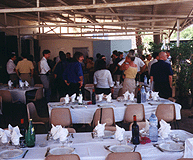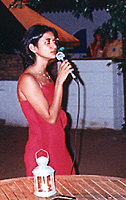|
|
ANIMATION WORLD MAGAZINE - ISSUE 5.12 - MARCH 2001
|
Standing at the Crossroads
This was followed by a delightful lunch served buffet-style under tents along the harbour ("Le Port"). Many participants took advantage of this opportunity to meet one another. The food was remarkable; a mixture of Indian ("cari" as in curry, "Massalé" as in Massala), Créole ("boudin," sausage), French (Bordeaux and Beaujolais wines, pastries), local rum, including "rhum arrangé," a rum in which herbs and spices have been steeped, and exotic fruits. I ate the very best mango ever. "Mangue Joseph" is a small, roundish fruit, very different from the usual oval fruit that I was familiar with, and a source of unbelievably deep and long lasting flavours. That same evening, we were invited to a party where Pipangaï celebrated its fifth anniversary. Pipangaï, the second largest European animation studio (in production volume), can deliver up to fifteen half-hour 2D animations per month. The studio has already produced in excess of 300 half-hour animated episodes sold in over 80 countries. It specializes in colorization, background painting and compositing -- basically, catering to the needs of animation studios in need of qualified yet affordable labour.
During this party, Alain Séraphine passed the torch to Azmina Goulamaly, now the new director of Pipangaï. Séraphine will focus his formidable energy and talents on the ILOI (Indian Ocean Institute of the Image), an institute that, along with the School of Fine Arts, could do much to not only develop local qualified labour, but also set the scene for the emergence of genuine local talent and vision (something that could go a long way toward lessening the dependence of la Réunion on projects from abroad). Cyberspace, Pipangaï and Movies Among the presentations, two individuals talked about Intranet communications and new technologies (Arnaud Lacaze Masmonteil, instructor at les Gobelins, and CEO of www.infotronique.fr) and the stakes of e-commerce (Julien Dufour, graduate of les Gobelins). What was immediately obvious were the differences in situation between France and North America. Figures showed that the percentage of the population now wired is a lot less in France than in the U.S. and Canada, but even more significant, were the percentages of those who are wired and trust on-line transactions. I would have thought that France, with its Minitel network (see http://www.minitel.fr) had a head start in entering the Web age, especially as far as e-commerce is concerned, but it does not yet seem to be the case. What I also noticed however was that these two young French IT specialists demonstrated not only a thorough knowledge of their field, but also a well rounded "general culture" as evidenced by their many references to things outside the narrow confines of their concentration. (I don't know too many North American "geeks" who could intelligently discuss the relative merits of L.-F. Céline's early and late works!)
|
||||||||



